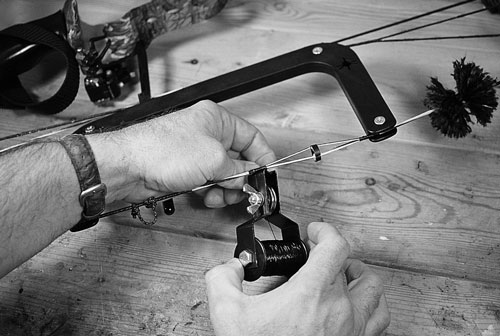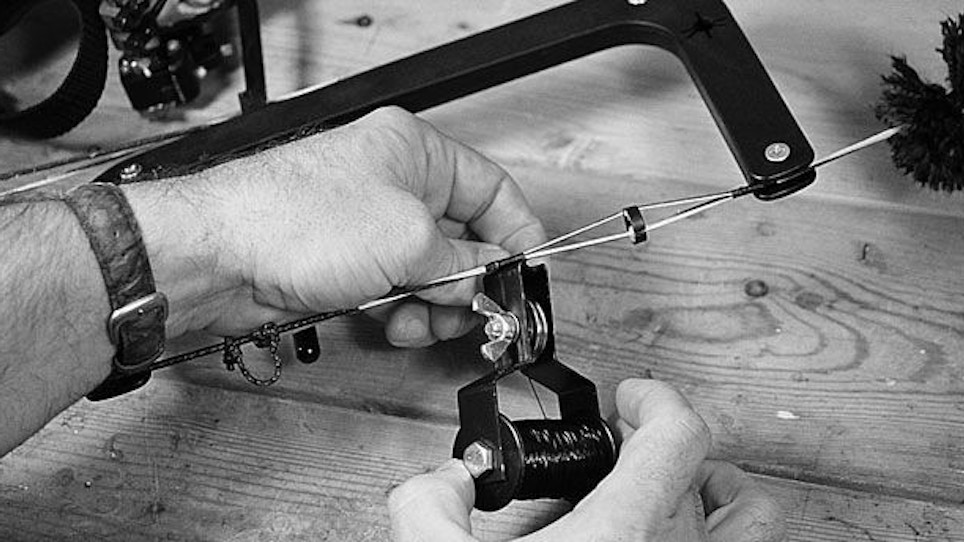Previously: Essential Tools For Your Toolbox
Useful, But Optional Tools
 Though some might argue the point, I believe a chronograph is a worthwhile, if not essential, investment for most bowhunters. A chronograph is the only practical way to accurately determine arrow speed, and arrow speed can be critical with today’s high-speed bows. At speeds of somewhere around 250 fps, setups become increasingly touchy and less forgiving, requiring perfect tuning and shooting form to steer broadhead-tipped arrows accurately. Using a chronograph, the bowhunter can determine arrow speed and use heavier arrows or back off on draw weight if the speed is too high.
Though some might argue the point, I believe a chronograph is a worthwhile, if not essential, investment for most bowhunters. A chronograph is the only practical way to accurately determine arrow speed, and arrow speed can be critical with today’s high-speed bows. At speeds of somewhere around 250 fps, setups become increasingly touchy and less forgiving, requiring perfect tuning and shooting form to steer broadhead-tipped arrows accurately. Using a chronograph, the bowhunter can determine arrow speed and use heavier arrows or back off on draw weight if the speed is too high.
On the flip side, a chronograph can enable hunters shooting at slower speeds to experiment with lighter arrows, increased draw weights, or any of a variety of accessories that promise to boost arrow speed. The hunter can increase speed to the point where shooting comfort or accuracy with broadheads begins to decline. This process helps achieve the best possible balance between high speed for flatter shooting and optimum penetration, and a setup that is reasonably accurate and forgiving in hunting situations.
While it’s certainly possible to perform most repairs or modifications without a bow press, a compound bow press enables many operations to be performed much more easily, quickly, and safely. Replacing strings or cables, or installing new cams to change draw length or letoff, or adjusting timing and cam orientation, are best done with a press.
Ideally, bowhunters will have two presses: A standard, bench-style press for use in the work area at home, and a portable press to use in the field.
Most bowhunters get by without an arrow saw, buying ready-to-shoot arrows or shafts cut-to-length. Taking raw shafts to a local pro shop and having them cut to length is another option. Good arrows are expensive, though, and buying raw, uncut shafts is one way to save a little money.
Bowhunters using aluminum arrows can buy inexpensive hand saws or shaft cut-off tools. (Be sure to get a deburring tool, since even the best saws may create burrs on aluminum shafts.) Though some inexpensive mechanical saws are billed as suitable for carbon shafts, in my experience they are not. Carbon shafts require a high-speed electric saw.
Fletch strippers save time and work, especially on aluminum arrows. Be careful using them on carbon arrows, since they can slice into the carbon and peel layers off the arrow, ruining the shaft.
An arrow straightener is a worthwhile investment for those bowhunters who use aluminum arrows. I list this as an option, and not an essential item, only because more and more hunters have gone to carbon arrows, and because the case can be made that when your aluminum arrow is bent, it’s time to replace it.
A broadhead wrench is a handy, inexpensive tool. Without it, you risk an almost-inevitable cut while installing a razor-sharp broadhead.
Put a broadhead sharpener on the “essential” list if you shoot fixed-blade broadheads. Broadhead sharpeners can be used on replaceable blades to save money. Whichever kind of broadheads you sharpen, take care not to throw the broadhead off balance, by “shaving” one blade more than the others.
Finally, with today’s speed bows, I’m a firm believer in paper tuning. Get along without it if you must, but a paper tuning rack or frame of some sort makes this chore much easier to perform. You might think a rack is a rack, but I’ve found you get what you pay for. Better to make a solid frame yourself and staple or tape paper to it than endure the frustrations of a lightweight, flimsy rack.
In addition to the items listed here, my own workbench is replete with generic tools such as needle-nose pliers, scissors, and X-Acto knives. I keep hammers at a safe distance from my work area, though there have been a few times when I was tempted to use one on an especially difficult-to-tune-bow.






